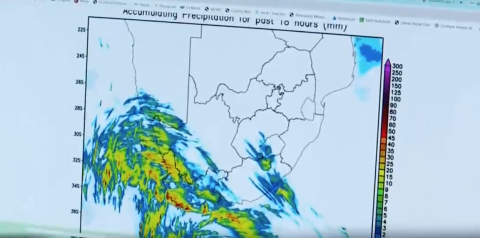Lake Chad's Water, Wetlands, and Dunes
An astronaut aboard the International Space Station captured this photograph of Central Africa’s Lake Chad, which once ranked among the largest natural lakes in the world.
Lake Chad spans the borders of four countries: Cameroon, Niger, Nigeria, and Chad. The lake’s main sources of water are the Chari and its tributary, the Logone. Both rivers flow into the southern side of the lake. Other rivers, like the Komadugu Yobe, empty into the lake’s western end. N’Djamena, Chad’s capital city, appears as a gray-toned area that blends into the surrounding landscape (bottom right).
As one of the lowest-lying areas in the immediate region, Lake Chad is the catchment for a large hydrographic basin. Ongoing droughts and the rising demand for fresh water have shrunk the lake to less than a tenth of the area it covered in the middle of the last century. Although the lake has experienced dry and wet periods for thousands of years, there has been a significant decline in the amount of lake water available since the 1960s.
The evolution of Lake Chad has been documented by astronaut photography over the past 60 years. During the Apollo 7 mission in 1968, an astronaut acquired an oblique photograph of the lake as one large body of water. In 1982, another photo from the space shuttle mission STS-5 recorded receding water levels and encroaching sand dunes. Wind gusts pick up fine grains of silty sand and deposit them downwind, creating dunes on what was once the lakebed. Transverse dunes indicate that the dune-forming winds are primarily from the northeast.
A photo taken in 2015 during space station Expedition 42 captured the lake’s remaining waters and wetlands in dark green, blue, and brown, contrasting with the sandy shades of the surrounding land. The continuing encroachment of dunes across the former expanse of the lake is well illustrated in this image.
Astronaut photograph ISS072-E-571857 was acquired on January 24, 2025, with a Nikon Z9 digital camera using a focal length of 50 millimeters. It is provided by the ISS Crew Earth Observations Facility and the Earth Science and Remote Sensing Unit at NASA Johnson Space Center. The image was taken by a member of the Expedition 72 crew. The image has been cropped and enhanced to improve contrast, and lens artifacts have been removed. The International Space Station Program supports the laboratory as part of the ISS National Lab to help astronauts take pictures of Earth that will be of the greatest value to scientists and the public, and to make those images freely available on the Internet. Additional images taken by astronauts and cosmonauts can be viewed at the NASA/JSC Gateway to Astronaut Photography of Earth. Caption by Wilfredo García López/Jacobs-JETS II Contract at NASA-JSC.









